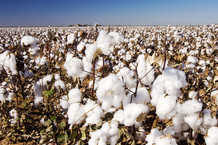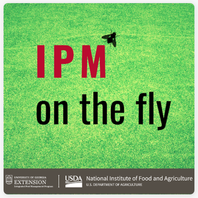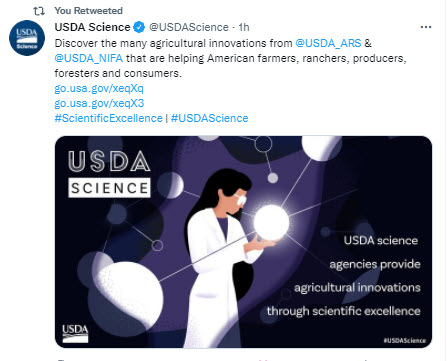|
Having trouble viewing this email? View it as a Web page.

|
|
|
Editor: Kelly Sprute October 27, 2021
Making a Difference

A stand of potatoes and tomatoes at a market, courtesy of Adobe Stock.
Study Predicts Two Popular American Foods Surprisingly Resilient to Climate Change
A new study led by researchers at the University of Florida predicts that the supply chains for two of Americans’ most popular plant-based foods, potatoes and tomatoes, are surprisingly resilient to climate change. To make their predictions, the researchers developed an innovative modeling approach to the assessment of climate adaptation and mitigation opportunities in fruit and vegetable supply chains.
The team has now applied their analysis method to carrots, green beans, spinach, strawberries, and sweet corn. The new research, published in Nature Food, is supported by a grant from USDA’s National Institute of Food and Agriculture. The inter-disciplinary research team includes other scientists from the International Food Policy Research Institute, University of Arkansas, University of Illinois, Washington State University and the World Agricultural Economic and Environmental Services. For more information, read this University of Florida blog article.
|
|

NIFA Invests Over $50M for Beginning Farmer and Rancher Development
NIFA announced today an investment of over $50 million to 140 organizations and institutions that teach and train beginning farmers and ranchers.
“Strengthening and growing the pipeline of the next generation of farmers and ranchers is vital to the continued success of American agriculture,” said NIFA Director Dr. Carrie Castille. “We recognize that beginning farmers and ranchers have unique needs for education, training, and technical assistance. Their success, especially in the first 10 years, often hinges on access to reliable, science-based information and the latest educational resources so they can improve their operations’ profitability and sustainability long-term.” For more information, read the NIFA press release.
NIFA invests over $50 million to train the next generation of farmers and ranchers. Image courtesy of Getty Images.
|

NIFA Invests Nearly $25M in Farm and Ranch Stress Assistance Network
NIFA announced today an investment of nearly $25 million for 50 grants supporting Farm and Ranch Stress Assistance Network State Department of Agriculture projects.
“NIFA’s Farm and Ranch Stress Assistance Network connects farmers, ranchers, and others in agriculture-related occupations to stress assistance programs,” said NIFA Director Dr. Carrie Castille. “Creating and expanding a network to assist farmers and ranchers in times of stress can increase behavioral health awareness, literacy, and positive outcomes for agricultural producers, workers and their families.” For more information, read the NIFA press release.
NIFA invests in stress assistance programs for farmers and ranchers. These programs provide vital support, ranging from mental health and legal issues to family and youth stress. Image courtesy of Getty Images.
|

New NIFA Partnership Enhances Workplace Inclusion
October marks National Disability Employment Awareness Month. During this time, we recognize and commemorate the contributions of people with disabilities to America’s workplaces and economy. To further advance USDA-National Institute of Food and Agriculture’s diverse and inclusive workplace, the agency has partnered with the Center for Disability Inclusion, which works alongside companies to strengthen outreach, recruitment, hiring and retention of employees with disabilities. This partnership will allow for additional disability training and networking opportunities with other agencies. For more information, read this NIFA blog.
Businesspeople at a project planning meeting, courtesy of Adobe Stock.
|

NIFA Career Opportunities
We are hiring! The National Institute of Food and Agriculture (NIFA) recruits a diverse group of talented, creative, motivated professionals who are invested in shaping the future of food and agricultural science. We offer a variety of benefits and services to our employees that focus on work-life balance, career enhancement, and health and well-being. NIFA has career opportunities in a variety of scientific disciplines covering engineering, food science, forestry, education, animal and crop sciences, and many other agriculture-related disciplines. NIFA job openings are listed on USAJobs. Current NIFA job openings are for Kansas City, Missouri, or location negotiable after selection.
Biological Science Specialist (GS 13-14)
Closing Date: November 1, or when we have received 50 applications.
View the job announcement.
|

98th Annual Agricultural Outlook Forum graphic, courtesy of the USDA.
USDA Opens Registration for the 2022 Agricultural Outlook Forum
Registration is now open for the 98th annual Agricultural Outlook Forum, USDA's largest annual meeting and premiere event. This virtual event will be held on February 24-25, 2022, and features a keynote address by Agriculture Secretary Tom Vilsack, a presentation on the 2022 agricultural economy by USDA’s Chief Economist Seth Meyer, a panel of distinguished guest speakers, and 30 breakout sessions organized by agencies across USDA and covering a range of timely issues impacting the sector. More than 100 government, industry, and academic leaders will share their perspectives and insights on a wide array of topics including commodity and food price outlooks, U.S. and global agricultural trade developments, climate change, and innovations in agricultural production and sustainability. The 2022 Forum theme and full program will be announced soon. For more information, read this USDA press release.

H2O in Space: Waste Not, Want Not
Water is critical in space. This is especially true for NASA’s planned long-term space missions, replete with on-board farming. At roughly 8.34 pounds per gallon, getting enough water aboard ship to irrigate crops and sustain astronauts is expensive, as every pound carried to space requires additional fuel, which incurs additional costs.
NASA worked with USDA’s Agricultural Research Service (ARS) and research partner Pancopia, Inc., to develop a water recycling system that will help them save money and water in space. For more information, read this USDA blog.
ARS scientists working with NASA to develop a water recycling system, courtesy of USDA-ARS.
|

Big Effort to Reduce Poultry-Related Salmonella Infections in Humans
Poultry companies are reducing Salmonella contamination in their products, but human illness cases continue. USDA’s Gary Crawford talks with USDA Deputy Under Secretary Sandra Eskin about how the USDA is redoubling their efforts to reduce Salmonella illnesses. For more information, listen to this USDA broadcast.
Checking for Salmonella in chicken, courtesy of Adobe Stock.
|

Popular Perennial Flowering Plants Can Attract Diverse Mix of Pollinators
Popular species of perennial flowering plants vary widely in their attractiveness to pollinators, but homeowners and landscape managers who select certain perennial cultivars can support a diverse community of pollinators in their own backyards, per a new study from a team of Pennsylvania State University researchers. To help optimize the ecological value of urban and suburban greenspaces and develop accurate recommendations for home gardeners and landscapers, the researchers studied 25 cultivars from these plants: giant hyssop, hummingbird mint, Echinacea, catmint, black-eyed Susan, and Salvia (sage). These plants can attract bees, flies, butterflies, and beetles, including many rare and vulnerable bee species. The study, published in Scientific Reports, found that Agastache 'Blue Fortune' giant hyssop received the most pollinator visitors. Funded by a USDA-NIFA Specialty Crop Research Initiative grant. For more information, read this Penn State News article.
A bumble bee visits the perennial cultivar Agastache 'Foeniculum' (anise hyssop), which researchers found to attract a high number of pollinators. Photo courtesy of Emily Erickson.
|

Grant to Study Regenerative Agriculture
"Oklahoma State University (OSU) has received more than $2.6 million to research ways to improve agricultural production while reducing environmental impacts," said OSU Director of the Oklahoma Water Resources Center Kevin Wagner. It will require a holistic approach, Wagner said. Climate, livestock grazing, crop rotation, hydrology, regional economics, and more--the systems in regenerative agriculture are just too large, complex, and intertwined for a simple solution. OSU researchers will work closely with Texas A&M AgriLife Research at Texas A&M University and other universities in the region on a five-year project funded by USDA’s National Institute of Food and Agriculture. For more information, read this OSU Ag Research article.
OSU researchers are focusing on regenerative agriculture for crops such as cotton. Image courtesy of Adobe Stock.
|

IPM on the Fly
Your House is a Cave
University of Georgia (UGA) Extension urban entomologist Dr. Dan Suiter talks about the most common fall bugs that like to seek shelter in our homes on the latest “ IPM On The Fly” podcast. These podcasts explore everyday pest issues from the home and garden to big commercial farms with experts providing sustainable common-sense solutions. NIFA funded. For more information, listen to the UGA podcast.
IPM On The Fly podcast icon, courtesy of the University of Georgia Extension.
|

MCSFR & RREA Administrative Meeting
The 2021 McIntire-Stennis Cooperative Forestry Research (MCSFR) and the Renewable Resources Extension Act (RREA) programs will hold two events (fall and spring) to identify opportunities, discuss challenges, and collaborate in addressing the sustainability of forest and rangeland resources through research, education, and extension strategies. The first meeting November 15 at 12 p.m. (CT) intends to connect MCSFR administrative technical representatives and RREA project directors through a series of talks, breakout groups, webinars, and guest speakers to learn about the latest changes in the reporting system, financial, and administrative management of the programs. For more information, go to the MSCFR and RREA webinar announcement.
Webinar graphic, courtesy of Adobe Stock.
|
Applying for Agriculture Business Innovation Center at an HBCU Institution
The FY 2021 Consolidated Appropriations Act, Section 766 (Public Law 116-260) authorized NIFA to issue a competitive grant to support the establishment of an Agriculture Business Innovation Center at a Historically Black College or University (HBCU). The Agriculture Business Innovation Center (ABIC) serves as a technical assistance hub to enhance agriculture-based business development opportunities.
NIFA staff will provide an overview of the Agriculture Business Innovation Center at an HBCU Institution program and the Request for Application process on November 16 at 1:30 p.m. CT. There will be time at the end of the webinar for Q&As. For more information, go to the ABIC webinar announcement.

|
|
|
NIFA’s mission is to invest in and advance agricultural research, education, and extension that solve societal challenges. NIFA’s investments in transformative science directly support the long-term prosperity and global preeminence of U.S. agriculture. Keep informed about NIFA, USDA, our land-grant and non-land-grant university partners, and stakeholders with the NIFA Update. Read past issues online, sign up for email updates or follow us on Twitter @USDA_NIFA, #NIFAImpacts or LinkedIn @usda-nifa.
If you wish to submit a news item or information, send an email to NIFAUpdate.
USDA is an equal opportunity lender, provider, and employer.
|
|
|
|